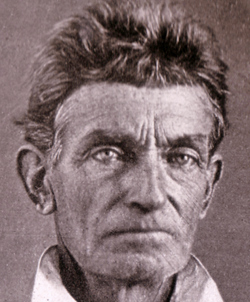 Rice University’s project The Papers of Jefferson Davis has been blogged about earlier, but there are two documents relevant to the Election of 1860 that I wanted to point out. The project is an attempt to compile all of Davis’s documents into a 15-volume set (twelve of which has been published so far), and in the process some of the important letters and speeches have been digitized as well. Volume 6 of the collection contains materials from the years 1856-1860, particularly two important documents from 1860: an Address to the National Democracy in May 1860 and a speech from Washington, D.C. in July 1860. The first document is a summary of the events of the Democratic National Convention that took place in Charleston and resulted in the splitting of the party into two factions over the slavery issue. Davis actually praises the “lofty manifestation of adherence to principle” displayed on the part of the Southern delegates who withdrew from the convention, but insists that if the demands of the Southern delegates are met during the new Baltimore convention “no motive will remain for refusing to unite with their sister States.” He appears to believe that the demands of the Southern “fire-eaters” may still be met by the other half of the Democratic party, and the party can unite once again in time for the election. The address urges Southern democrats to await the outcome of the Baltimore convention before holding their own convention in Richmond, and was affirmed by 18 members of Congress. Jefferson Davis’s speech from Washington, D.C. in July of 1860 presents a markedly different tone. The speech is short, but it sends the powerful message that although the Democratic party is split, it is not dead. He contrasts the Southern Democratic party with the other three parties, calling the Northern Democrats a “spurious and decayed off-shoot of democracy,” and bemoaning “Abe Lincoln’s efforts to rend the Union.” Finally he endorses John Breckinridge for president, declaring that “he has split a hundred rails to Lincoln’s one!” These two primary documents demonstrate the progression of the splitting of the Democratic party in a very clear way, from the hopeful moment that the party can again unify to the finality of the factions nominating different candidates for president.
Rice University’s project The Papers of Jefferson Davis has been blogged about earlier, but there are two documents relevant to the Election of 1860 that I wanted to point out. The project is an attempt to compile all of Davis’s documents into a 15-volume set (twelve of which has been published so far), and in the process some of the important letters and speeches have been digitized as well. Volume 6 of the collection contains materials from the years 1856-1860, particularly two important documents from 1860: an Address to the National Democracy in May 1860 and a speech from Washington, D.C. in July 1860. The first document is a summary of the events of the Democratic National Convention that took place in Charleston and resulted in the splitting of the party into two factions over the slavery issue. Davis actually praises the “lofty manifestation of adherence to principle” displayed on the part of the Southern delegates who withdrew from the convention, but insists that if the demands of the Southern delegates are met during the new Baltimore convention “no motive will remain for refusing to unite with their sister States.” He appears to believe that the demands of the Southern “fire-eaters” may still be met by the other half of the Democratic party, and the party can unite once again in time for the election. The address urges Southern democrats to await the outcome of the Baltimore convention before holding their own convention in Richmond, and was affirmed by 18 members of Congress. Jefferson Davis’s speech from Washington, D.C. in July of 1860 presents a markedly different tone. The speech is short, but it sends the powerful message that although the Democratic party is split, it is not dead. He contrasts the Southern Democratic party with the other three parties, calling the Northern Democrats a “spurious and decayed off-shoot of democracy,” and bemoaning “Abe Lincoln’s efforts to rend the Union.” Finally he endorses John Breckinridge for president, declaring that “he has split a hundred rails to Lincoln’s one!” These two primary documents demonstrate the progression of the splitting of the Democratic party in a very clear way, from the hopeful moment that the party can again unify to the finality of the factions nominating different candidates for president.
9
Mar
10
Papers of Jefferson Davis
Posted by Published in Antebellum (1840-1861), Letters & Diaries Themes: Contests & Elections5
Mar
10
Upper South and the Secession Crisis
Posted by sailerd Published in Antebellum (1840-1861), Letters & Diaries Themes: Education & Culture, Slavery & AbolitionI already described DocSouth’s online exhibit on antebellum students at UNC-Chapel Hill, but this letter from March 1861 provides an interesting example of the Upper South’s role in the secession crisis. Even though “Lincoln’s inaugural…amounts to coersion [sic],” John Halliburton believed that “[he could] hate him and still love the Union.” Pro-secession editorials were “absurdities,” as Halliburton noted. Of course many southerners reached similar conclusions. The Fayetteville Observer reported in February 1861 that Tennessee voters “not only [gave] an overwhelming majority for the Union candidates, but voted down the [Secession] Convention itself.” Yet their support for the Union was not unconditional. Disunion remained an option under the right conditions. While the Observer never expected any “violation of [the South’s] rights from [Lincoln’s] administration,” this conditional unionist newspaper considered secession a legitimate response. After Confederates attacked Fort Sumter and President Lincoln called for 75,000 volunteers in April 1861, North Carolina left the Union and Halliburton presumably changed his mind as he enlisted in the Confederate army later that year.
2
Mar
10
Lincoln at Cooper Union
Posted by Published in Antebellum (1840-1861), Letters & Diaries Themes: Contests & Elections On February 27, 1860, Abraham Lincoln made a landmark speech in his political career at the Cooper Institute in Manhattan, now known as the Cooper Union Address. This speech catapulted the Illinois senator onto the national scene and Lincoln scholars such as Harold Holzer believe that this speech secured his nomination as the Republican party candidate. By extension, this address is seen as a pivotal moment in 1860 that made Lincoln president. Whether or not this was the moment that Lincoln secured his presidency, the speech is critical to any study of the election of 1860. It introduced Lincoln to an audience in the East and caught the attention of Republican party leaders there as well. Lincoln chose to discuss the views of the framers of the Constitution on slavery and states’ rights, a topic that required a great deal of in-depth research. The speech is heavily grounded in historical fact, and shows Lincoln’s ability to articulate his ideas in a clear, logical fashion. In addition to the speech, a photograph (seen at right) taken of Lincoln before the address by Matthew Brady became crucial to the presidential campaign as many campaign posters were based on it. In compiling its digital exhibition celebrating Lincoln’s bicentennial entitled With Malice Towards None, the Library of Congress included the Cooper Union Address and the Cooper Union Portrait in its section on the Road to the Nomination. This project contains an 1860 copy of the speech as campaign literature.
On February 27, 1860, Abraham Lincoln made a landmark speech in his political career at the Cooper Institute in Manhattan, now known as the Cooper Union Address. This speech catapulted the Illinois senator onto the national scene and Lincoln scholars such as Harold Holzer believe that this speech secured his nomination as the Republican party candidate. By extension, this address is seen as a pivotal moment in 1860 that made Lincoln president. Whether or not this was the moment that Lincoln secured his presidency, the speech is critical to any study of the election of 1860. It introduced Lincoln to an audience in the East and caught the attention of Republican party leaders there as well. Lincoln chose to discuss the views of the framers of the Constitution on slavery and states’ rights, a topic that required a great deal of in-depth research. The speech is heavily grounded in historical fact, and shows Lincoln’s ability to articulate his ideas in a clear, logical fashion. In addition to the speech, a photograph (seen at right) taken of Lincoln before the address by Matthew Brady became crucial to the presidential campaign as many campaign posters were based on it. In compiling its digital exhibition celebrating Lincoln’s bicentennial entitled With Malice Towards None, the Library of Congress included the Cooper Union Address and the Cooper Union Portrait in its section on the Road to the Nomination. This project contains an 1860 copy of the speech as campaign literature.
16
Feb
10
North Carolina and the Election of 1860
Posted by Published in Antebellum (1840-1861), Letters & Diaries Themes: Contests & Elections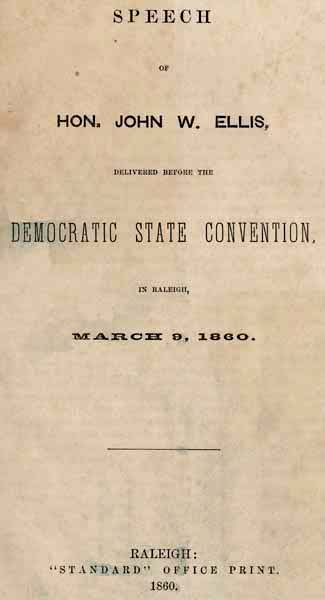 As previously mentioned in this blog, the University of North Carolina at Chapel Hill supports a fantastic website for researching all aspects of the South during the Civil War era called Documenting the American South. On this website, there are several important resources that relate to the crucial election of 1860. A simple search of the collection for the term “election of 1860” does not yield much relevant information; therefore, as is often the case, the subject index is more useful for finding these materials. In this instance, the best materials are found under the heading United States — Politics and Government — 1857-1861. An important document found here is John Willis Ellis’s speech at the 1860 North Carolina Democratic Convention. It presents a look into the Democratic party in North Carolina leading up to the election of 1860. While the speech was an acceptance of his party’s nomination for a second term as governor, Ellis focused on national issues in his address. He attacked William H. Seward, then running for the Republican presidential nomination, and called on Democrats to overlook the divisive issue of the ad valorem tax in favor of party unity. This was supported by western Democrats but opposed by eastern Democrats because it taxed slaves at lower rates. The division of the Democratic party along this (and other) lines was a deciding factor in Republican Abraham Lincoln’s election to the presidency in 1860. In this speech, Governor Ellis saw the divisions already forming in the party, however his warnings were not enough to unite the Democrats.
As previously mentioned in this blog, the University of North Carolina at Chapel Hill supports a fantastic website for researching all aspects of the South during the Civil War era called Documenting the American South. On this website, there are several important resources that relate to the crucial election of 1860. A simple search of the collection for the term “election of 1860” does not yield much relevant information; therefore, as is often the case, the subject index is more useful for finding these materials. In this instance, the best materials are found under the heading United States — Politics and Government — 1857-1861. An important document found here is John Willis Ellis’s speech at the 1860 North Carolina Democratic Convention. It presents a look into the Democratic party in North Carolina leading up to the election of 1860. While the speech was an acceptance of his party’s nomination for a second term as governor, Ellis focused on national issues in his address. He attacked William H. Seward, then running for the Republican presidential nomination, and called on Democrats to overlook the divisive issue of the ad valorem tax in favor of party unity. This was supported by western Democrats but opposed by eastern Democrats because it taxed slaves at lower rates. The division of the Democratic party along this (and other) lines was a deciding factor in Republican Abraham Lincoln’s election to the presidency in 1860. In this speech, Governor Ellis saw the divisions already forming in the party, however his warnings were not enough to unite the Democrats.
15
Feb
10
Conference Commemorating the 150th Anniversary of the Harpers Ferry Raid
Posted by sailerd Published in Antebellum (1840-1861), Video Themes: Slavery & Abolition“John Brown, Slavery, and the Legacies of Revolutionary Violence in Our Own Time,” a conference held in October 2009 at the Gilder Lehrman Center for the Study of Slavery, Resistance, and Abolition (Yale University), is now available online. Over twenty scholars participated in this event, which included four different sessions – “John Brown: A Problem in Biography,” “John Brown and the Arts,” “John Brown and the Legacies of Violence,” “John Brown and Abolitionism.” One can also watch the keynote address (W. Fitzhugh Brundage) and the concluding roundtable (David Blight, Russell Banks, and Tony Horwitz). More information about all of the conference participations is available here. Videos from several other events at the Gilder Lehrman Center are also online, including a discussion with historians David W. Blight Drew Gilpin Faust about Faust’s recent book, The Republic of Suffering: Death and the American Civil War (2008).
13
Feb
10
Seeing Slavery in a Digital Age
Posted by Matthew Pinsker Published in Antebellum (1840-1861), Rare Books Themes: Slavery & Abolition One of the great wonders of the digital age is the ability to read rare books and documents from your desktop. Admittedly, reading online isn’t always easy or fun, but nothing compares to ease of access or the ability to search the full text of these resources. A great case study for this brave new world lies with the study of slavery. There are now thousands of ex-slave narratives, pro- and anti-slavery pamphlets and important nineteenth-century accounts of the peculiar institution, such as Frederick Law Olmsted’s Journey in the Seabord Slave States (1856) that can be searched and researched at greater speed and with more diverse perspectives than ever before. Two of the best digital collections of slavery-related materials are from the University of North Carolina Library’s prize-winning Documenting the American South website and also a newer site called Slavery & Abolition in the US from Dickinson College and Millersville University. Both feature a wide variety of primary source texts that can be searched fruitfully for references to particular topics. For example, a persistent and creative student can look for and find references to antebellum plantation practices or customs such as childhood experiences, relationships with plantation mistresses or the practice of Christianity by slaves. They can compare how abolitionists and pro-slavery pamphleteers argued over “wage slavery” and the treatment of northern workers. Naturally, all of this and much more research has been done before the advent of the Internet, but full-text searching makes such projects much easier. Students in my Civil War class are preparing to launch their own projects on slavery. I hope they will use this blog post to demonstrate my point by commenting on some initial connections they have made between two or more sources in either the DocSouth site or the Slavery & Abolition collection. Please feel free to share quotations and links from rare books that contain insights on the institution of slavery or about the fight over its continued existence in nineteenth-century America. Also, please feel free to report on any frustrations or challenges in using either of these digital collections. They are helpful, but they are not perfect. And, of course, any other readers of the blog should feel encouraged to jump in with their own observations and reports from the front-lines of research and teaching in a digital age.
One of the great wonders of the digital age is the ability to read rare books and documents from your desktop. Admittedly, reading online isn’t always easy or fun, but nothing compares to ease of access or the ability to search the full text of these resources. A great case study for this brave new world lies with the study of slavery. There are now thousands of ex-slave narratives, pro- and anti-slavery pamphlets and important nineteenth-century accounts of the peculiar institution, such as Frederick Law Olmsted’s Journey in the Seabord Slave States (1856) that can be searched and researched at greater speed and with more diverse perspectives than ever before. Two of the best digital collections of slavery-related materials are from the University of North Carolina Library’s prize-winning Documenting the American South website and also a newer site called Slavery & Abolition in the US from Dickinson College and Millersville University. Both feature a wide variety of primary source texts that can be searched fruitfully for references to particular topics. For example, a persistent and creative student can look for and find references to antebellum plantation practices or customs such as childhood experiences, relationships with plantation mistresses or the practice of Christianity by slaves. They can compare how abolitionists and pro-slavery pamphleteers argued over “wage slavery” and the treatment of northern workers. Naturally, all of this and much more research has been done before the advent of the Internet, but full-text searching makes such projects much easier. Students in my Civil War class are preparing to launch their own projects on slavery. I hope they will use this blog post to demonstrate my point by commenting on some initial connections they have made between two or more sources in either the DocSouth site or the Slavery & Abolition collection. Please feel free to share quotations and links from rare books that contain insights on the institution of slavery or about the fight over its continued existence in nineteenth-century America. Also, please feel free to report on any frustrations or challenges in using either of these digital collections. They are helpful, but they are not perfect. And, of course, any other readers of the blog should feel encouraged to jump in with their own observations and reports from the front-lines of research and teaching in a digital age.
8
Feb
10
HarpWeek Political Cartoons
Posted by Published in Antebellum (1840-1861), Images, Lesson Plans Themes: Contests & Elections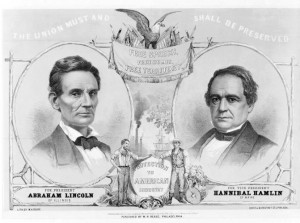 HarpWeek has an online collection of political cartoons from 14 presidential elections between the years 1860-1912. These cartoons provide a visual insight into the climate surrounding the Election of 1860, and its core issues. Some of the cartoons require a lot of prior historical knowledge, while others can be understood with some basic analysis. HarpWeek has convienently provided an analysis and explanation of each cartoon. There are other resources as well for the Election of 1860, including an overview of the historical context and a timeline of important events. Any of these political cartoons would be beneficial to a classroom discussion of this crucial election. This webpage provides a useful guide to using editorial cartoons in the classroom.
HarpWeek has an online collection of political cartoons from 14 presidential elections between the years 1860-1912. These cartoons provide a visual insight into the climate surrounding the Election of 1860, and its core issues. Some of the cartoons require a lot of prior historical knowledge, while others can be understood with some basic analysis. HarpWeek has convienently provided an analysis and explanation of each cartoon. There are other resources as well for the Election of 1860, including an overview of the historical context and a timeline of important events. Any of these political cartoons would be beneficial to a classroom discussion of this crucial election. This webpage provides a useful guide to using editorial cartoons in the classroom.
8
Feb
10
VMI Cadets & John Brown’s Execution – Dec. 1859
Posted by sailerd Published in Antebellum (1840-1861), Images, Letters & Diaries Themes: Slavery & Abolition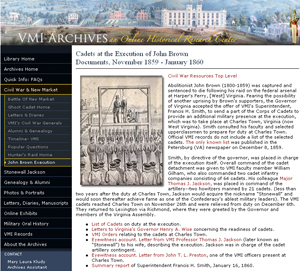 The Virginia Military Institute has a number of interesting digital collections related to the Civil War era, including one that focuses on the school’s involvement in John Brown’s execution. After Brown’s raid on Harpers Ferry in October 1859, VMI Superintendent Francis H. Smith wrote Virginia Governor Henry Wise and offered to send some of the cadets to Charles Town, Virginia to provide extra security for the execution. After the cadets arrived in late November 1859, their commanding officer reminded them that he “expected…[everyone] to abstain from impropriety which could by possibility impair the standing of the corps.” This collection includes Superintendent Smith’s letters to Gov. Wise, Smith’s report on the deployment, orders issued to the cadets, and eyewitness accounts from VMI Prof. Thomas J. Jackson and John T. L. Preston.
The Virginia Military Institute has a number of interesting digital collections related to the Civil War era, including one that focuses on the school’s involvement in John Brown’s execution. After Brown’s raid on Harpers Ferry in October 1859, VMI Superintendent Francis H. Smith wrote Virginia Governor Henry Wise and offered to send some of the cadets to Charles Town, Virginia to provide extra security for the execution. After the cadets arrived in late November 1859, their commanding officer reminded them that he “expected…[everyone] to abstain from impropriety which could by possibility impair the standing of the corps.” This collection includes Superintendent Smith’s letters to Gov. Wise, Smith’s report on the deployment, orders issued to the cadets, and eyewitness accounts from VMI Prof. Thomas J. Jackson and John T. L. Preston.
3
Feb
10
Help Improve the UGRR Digital Classroom
Posted by Matthew Pinsker Published in Antebellum (1840-1861), Images, Lesson Plans, Letters & Diaries Themes: Slavery & Abolition James McPherson writes in Battle Cry of Freedom (1989) that “On all issues but one, antebellum southerners stood for state’s rights and a weak federal government” (p. 78). Yet that one exception –the fugitive slave law– was a principal cause of the coming Civil War and potentially changes one’s view of the war’s meaning. White southerners were repeatedly infuriated by signs of northern resistance to the fugitive slave law. Abolitionists even taunted them by dubbing their efforts to help runaways an “Underground Railroad.” There was essentially a low-grade border war between North and South over this issue that lasted more than a decade and drove the conflict as much as the crisis over the western territories. Not everybody, not even McPherson, sees the impact of the Underground Railroad as looming this large during the antebellum period, but most of us at the House Divided Project do. That is why the first digital classroom we created was about the Underground Railroad. Partly funded by the NEH, this site offers a host of resources, including historic documents, images, interviews with leading scholars, Google Earth field trips, dozens of K-12 lesson plans and many more tools for the classroom. Especially since this is Black History Month, I hope readers of this blog post will use this opportunity to check out or reexamine these resources and post comments below offering feedback. Everything in the House Divided Project is still in what we are calling a draft edition –all can be fixed, improved or changed as we move toward a public launch during the Civil War 150th commemoration (2011-15).
James McPherson writes in Battle Cry of Freedom (1989) that “On all issues but one, antebellum southerners stood for state’s rights and a weak federal government” (p. 78). Yet that one exception –the fugitive slave law– was a principal cause of the coming Civil War and potentially changes one’s view of the war’s meaning. White southerners were repeatedly infuriated by signs of northern resistance to the fugitive slave law. Abolitionists even taunted them by dubbing their efforts to help runaways an “Underground Railroad.” There was essentially a low-grade border war between North and South over this issue that lasted more than a decade and drove the conflict as much as the crisis over the western territories. Not everybody, not even McPherson, sees the impact of the Underground Railroad as looming this large during the antebellum period, but most of us at the House Divided Project do. That is why the first digital classroom we created was about the Underground Railroad. Partly funded by the NEH, this site offers a host of resources, including historic documents, images, interviews with leading scholars, Google Earth field trips, dozens of K-12 lesson plans and many more tools for the classroom. Especially since this is Black History Month, I hope readers of this blog post will use this opportunity to check out or reexamine these resources and post comments below offering feedback. Everything in the House Divided Project is still in what we are calling a draft edition –all can be fixed, improved or changed as we move toward a public launch during the Civil War 150th commemoration (2011-15).
21
Jan
10
Post Office and the Press
Posted by sailerd Published in Antebellum (1840-1861), Historic Periodicals Themes: Slavery & Abolition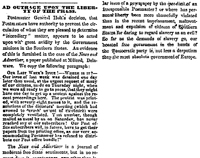 The United States Post Office had an important role in suppressing antislavery material in slave states before the Civil War. Newspapers and books, such as the New York Tribune and Hinton Rowan Helper’s The Impending Crisis of the South (1857), were not always distributed in southern states.The Chicago Press and Tribune, which supported the Republican party, was one of many northern papers that published specific examples. One article from January 1860 is particularly interesting since it described an incident in Delaware, a slave state. The Millord News and Advertiser had complained that their local “Postmaster [had] refused to distribute” the paper. While “[it was] a journal of moderate free State sentiments,” the Chicago Tribune explained that that paper “in no respect…countenance any other than legal and constitutional measures for the gradual removal of slavery from its own State.” Yet apparently even that stance was enough for a ban. When “our boasted free government [was]… in the hands of” Democrats, the Tribune concluded that it was “not less a despotism than the most absolute government of Europe.”
The United States Post Office had an important role in suppressing antislavery material in slave states before the Civil War. Newspapers and books, such as the New York Tribune and Hinton Rowan Helper’s The Impending Crisis of the South (1857), were not always distributed in southern states.The Chicago Press and Tribune, which supported the Republican party, was one of many northern papers that published specific examples. One article from January 1860 is particularly interesting since it described an incident in Delaware, a slave state. The Millord News and Advertiser had complained that their local “Postmaster [had] refused to distribute” the paper. While “[it was] a journal of moderate free State sentiments,” the Chicago Tribune explained that that paper “in no respect…countenance any other than legal and constitutional measures for the gradual removal of slavery from its own State.” Yet apparently even that stance was enough for a ban. When “our boasted free government [was]… in the hands of” Democrats, the Tribune concluded that it was “not less a despotism than the most absolute government of Europe.”

